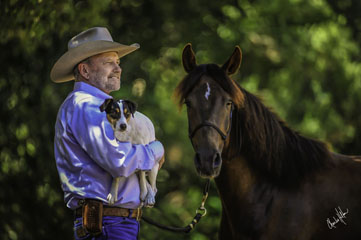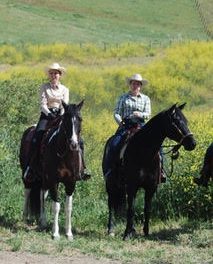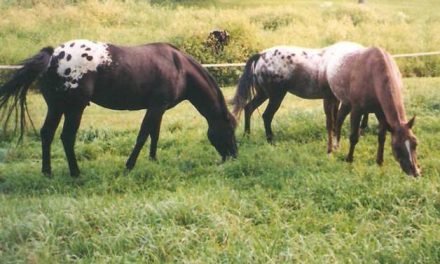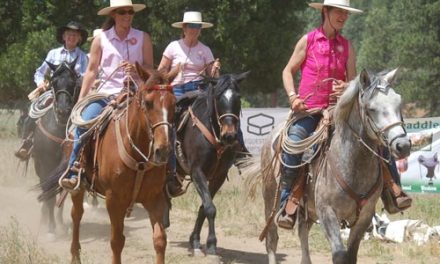
I personally do not believe in giving treats when training because a horse is a very
easily conditioned animal. When I was located at a training facility that I drove to
every morning, my horses would nicker and come running up to the end of the
paddock because they recognized the sound of my diesel engine even before they
saw the truck. It became a conditioned response for them. Most people thought that
was nice and that they loved me but actually they knew that once I got there, they
would soon be fed. They also got to be aggressive, running into the stall, nickering
and basically yelling feed me, feed me, feed me. They would crowd the gate
opening and it was hard to get the hay into it. This was some twenty years ago and
it was then I began to see the importance of appropriate stall manners. Running
into the stall and making a big ruckus, charging the gate to get at the food was just
not appropriate or safe. I had to teach them manners. I taught them to stay at the
back of the stall and they learned that they were not to rush in and crowd me when
I opened the gate to throw in the hay. They learned to wait until I gave them the
okay to come in.
So, what has that got to do with giving training and treats? It is the situation, the
horse looking for and expecting food. I had a client at the barn who gave carrots to
five or six horses every time she came in. They began to nicker when they saw her
and even though she put the carrots in the feed bins, the horses became aggressive.
She found that it was difficult to give the carrots because the horses were crowding
the openings. It was the same basic situation. Horses conditioned to receiving food
and becoming aggressive when it was not given fast enough.
The point is that we should not establish a pattern and we should establish respect.
Teaching people to require respect from their horses is a difficult lesson to get
across. Most everyone would agree that when we are working with a horse, we
want to use the least amount of pressure when we ask for something. For example,
if the horse moves into our space we ask it nicely to move back. This is a lesson
that is easy to teach. What is not so easy to teach is that when the horse doesn’t
move back, you must increase the pressure in order to maintain the horse’s respect.
Most people understand this principle intellectually but in reality can’t follow
through with enough force. Follow through often forces us to get out of our
comfort zone but for safety, if nothing else, it is essential that we have the respect
of our horses.
In 40+ years of training problem horses, performance horses and starting colts, my
experience is that people do not follow through. Once I have trained a horse and
the horse knows the correct cues, I want my clients to know and use those cues
correctly when riding the horse. In doing that the owner will earn the same level of
respect from the horse that I have established. If the owner does not use the cues
correctly or follow through when the horse tests, the horse will not respect the
owner. Having the respect of the horse is a big deal. It not only makes for a more
pleasant relationship, it makes the horse safer to be around.
Unfortunately, no matter how many times I say how valuable ground work is, I
find that most people don’t want to spend time doing ground work. Ground or in
hand work can teach a horse to be respectful and make a huge difference when we
get in the saddle. When I see a horse dancing at the end of a lead line, I know
immediately that horse has no respect for the person leading it. Most people have a
difficult time teaching the horse to have good ground manners and maintaining
those manners. It takes consistency and follow through. If a horse is not behaving
well and you give it a treat, you are re-enforcing the behavior and teaching it to be
disrespectful.
There are trainers, called clicker trainers, who use treats as training rewards. Even
they will tell you that it requires finesse and perseverance to transfer a horse who
has been trained by receiving treats to performance without the reward. I’ve seen
well known clicker training clinicians who do a very good job but constantly have
the horses in their space looking for that treat. While this method works, I don’t
believe it is the best way to train a horse. Train your horse to recognize and
respond to cues. Be consistent in your use of the cues and follow through until the
horse responds. Any horse can be trained or taught to do tricks like bowing, rearing
and going up on a pedestal even without treats.
I have had many a person come to me and say their horse won’t load into the
trailer. I usually find that the horse was taught to go into the trailer using treats or
hay. This may work at times however, when a horse’s emotional level is high, for
whatever reason, food will not work. When there is no physical cue, there is no
way a horse will go into a trailer. A horse that is frightened or hurt or simply upset
will not respond to the lure of food. I’ve seen butt ropes, brooms and rakes used on
horses to get them to load and they still won’t go in. I find that overall, no matter
the discipline, anything to do with treats usually jeopardizes my client’s safety. In
this industry at least 85% of the clientele are women and safety is always the first
concern. If you use treats to teach your horse and you are able to maintain his
respect, he keeps his distance and does not step into your space, then you are
probably one in a thousand. This doesn’t mean that giving treats doesn’t work to
train a horse but I don’t believe it is the best way.




